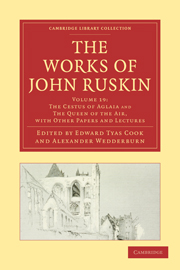Book contents
- Frontmatter
- Contents
- LIST OF ILLUSTRATIONS
- INTRODUCTION TO THIS VOLUME
- PART I “SIR JOSHUA AND HOLBEIN” (1860)
- PART II “THE STUDY OF ARCHITECTURE IN SCHOOLS” (1865)
- PART III “THE CESTUS OF AGLAIA” (1865, 1866)
- PART IV “THE RELATION OF NATIONAL ETHICS TO NATIONAL ARTS,” BEING THE REDE LECTURE FOR 1867
- PART V “ON THE PRESENT STATE OF MODERN ART, WITH REFERENCE TO THE ADVISABLE ARRANGEMENT OF A NATIONAL GALLERY” (1867)
- PART VI “FAIRY STORIES”: A PREFACE TO “GERMAN POPULAR STORIES” (1868)
- PART VII “THE FLAMBOYANT ARCHITECTURE OF THE VALLEY OF THE SOMME” (1869)
- PART VIII “THE QUEEN OF THE AIR” (1869)
- PART IX “VERONA, AND ITS RIVERS” (1870)
- APPENDIX: REPORTS OF ADDRESSES ON ART
- Plate section
PART I - “SIR JOSHUA AND HOLBEIN” (1860)
Published online by Cambridge University Press: 05 November 2011
- Frontmatter
- Contents
- LIST OF ILLUSTRATIONS
- INTRODUCTION TO THIS VOLUME
- PART I “SIR JOSHUA AND HOLBEIN” (1860)
- PART II “THE STUDY OF ARCHITECTURE IN SCHOOLS” (1865)
- PART III “THE CESTUS OF AGLAIA” (1865, 1866)
- PART IV “THE RELATION OF NATIONAL ETHICS TO NATIONAL ARTS,” BEING THE REDE LECTURE FOR 1867
- PART V “ON THE PRESENT STATE OF MODERN ART, WITH REFERENCE TO THE ADVISABLE ARRANGEMENT OF A NATIONAL GALLERY” (1867)
- PART VI “FAIRY STORIES”: A PREFACE TO “GERMAN POPULAR STORIES” (1868)
- PART VII “THE FLAMBOYANT ARCHITECTURE OF THE VALLEY OF THE SOMME” (1869)
- PART VIII “THE QUEEN OF THE AIR” (1869)
- PART IX “VERONA, AND ITS RIVERS” (1870)
- APPENDIX: REPORTS OF ADDRESSES ON ART
- Plate section
Summary
1. Long ago discarded from our National Gallery, with the contempt logically due to national or English pictures,—lost to sight and memory for many a year in the Ogygian seclusions of Marlborough House—there have reappeared at last, in more honourable exile at Kensington, two great pictures by Sir Joshua Reynolds. Two, with others; but these alone worth many an entanglement among the cross-roads of the West, to see for half-an-hour by spring sunshine:—the Holy Family, and the Graces, side by side now in the principal room. Great, as ever was work wrought by man. In placid strength, and subtlest science, unsurpassed;—in sweet felicity, incomparable.
2. If you truly want to know what good work of painter's hand is, study those two pictures from side to side, and miss no inch of them (you will hardly, eventually, be inclined to miss one): in some respects there is no execution like it; none so open in the magic. For the work of other great men is hidden in its wonderfulness—you cannot see how it was done. But in Sir Joshua's there is no mystery: it is all amazement. No question but that the touch was so laid; only that it could have been so laid, is a marvel for ever. So also there is no painting so majestic in sweetness. He is lily-sceptred: his power blossoms, but burdens not. All other men of equal dignity paint more slowly; all others of equal force paint less lightly.
- Type
- Chapter
- Information
- The Works of John Ruskin , pp. 1 - 16Publisher: Cambridge University PressPrint publication year: 2010First published in: 1905

